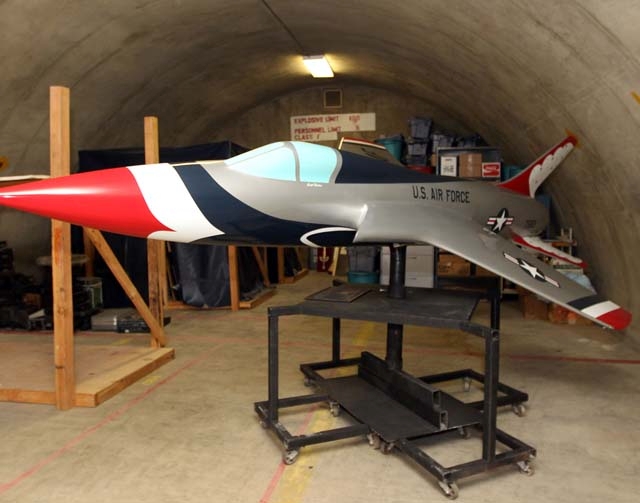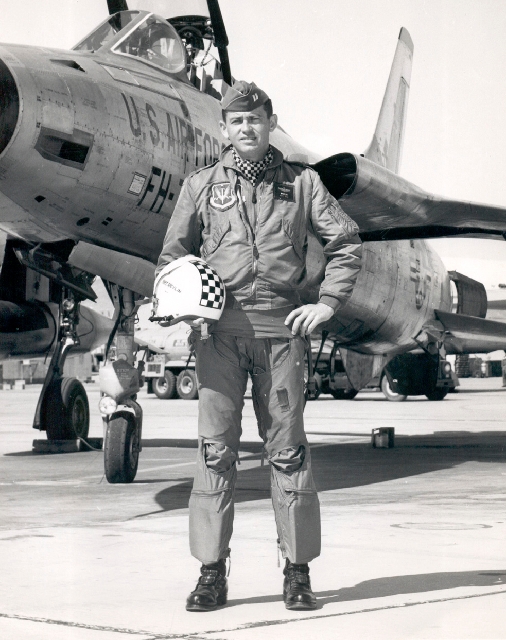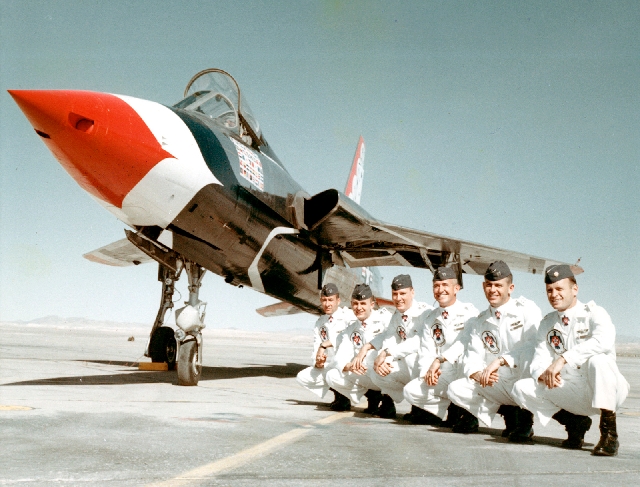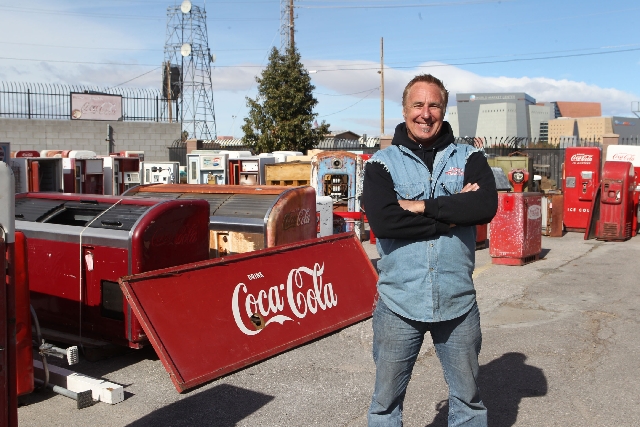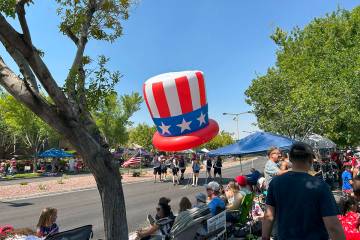Restored fighter jet replica to be displayed
It was forgotten but not lost.
The 1960s replica of the red, white and blue Thunderchief fighter jet had stood nearly three decades perched on a pedestal near the Nellis Air Force Base main gate.
The one-twelfth scale model of Republic Aviation’s F-105 — a Vietnam War workhorse nicknamed the “Thunder Thud,” for the more than 350 that were shot down or crashed — had welcomed thousands of airmen stationed at the Las Vegas base.
It also greeted many more thousands of spectators who came to watch the Thunderbirds perform daring, neck-craning loops and breathtaking rolls.
It was a tribute to a fallen pilot that had been yanked down in 1999 and stowed in a remote hangar when the entrance road was realigned.
With the turnover of the Thunderbirds team every two years, knowledge of the replica’s storage location had vanished with the institutional memory that departing team members took with them.
The sun-baked fiberglass model, with its faded blue stars and red-trim-turned-pink, had been separated from the plaque that explained its significance: “In the honor of Capt. Gene Devlin, who lost his life on May 9, 1964 while serving his country as a U.S. Air Force Thunderbird. This memorial is dedicated to all whose common bond is uncommon devotion to duty.”
When Tech. Sgt. Anthony Graham, the team’s quality insurance inspector, got a call to retrieve the replica from a Red Horse Squadron hangar being demolished, he had no idea what to expect.
“I almost had a heart attack,” he said on a drizzly January morning. “It was hollow inside and there were all kinds of critters living there. It broke my heart.”
At first he didn’t recognize it. “But when I actually came over and saw his name on the canopy, that’s when it hit me. I knew this was a memorial for him and I wondered, ‘Where’s the rest of it?’ I went around the door and that’s when I saw the pedestal with the memorial plaque on it.”
Graham, 35, immediately raised the prospect of restoring it with his team leaders. After all, from the time it was installed as a gift from Republic Aviation in 1974 until it was taken down 25 years later, it had been a symbol of freedom and sacrifice portrayed by a captain from the “ambassadors in blue.”
It was more than plastic and paint, as Graham would find out. It was really about honor, perfection and brotherhood.
AMERICAN RESTORATION
With a $10,000 donation from the Thunderbirds Alumni Association, the pieces of the restoration project fell into place.
“I wanted somebody local to do it. And I knew that Rick (Dale), of Rick’s Restorations could handle it. I’ve seen his work,” Graham said, referring to the History channel’s “American Restoration” program.
After one glance at the disheveled model, “Rick was like, ‘Holy crap! That’s a lot of work.’u2009”
But Dale welcomed the task, saying on the segment’s Nov. 28 debut that the project brought his life “full circle as a child all the way to now as an ‘old man.’u2009”
Dale, 54, wearing his signature sleeveless denim shirt, discussed his task in a Jan. 29 interview at his office.
“As a kid when my parents took me out there, I always saw this plane sitting in front of the entrance. It was very iconic,” he said.
“I had no clue what it meant. I just thought it was a plane in front of Nellis Air Force Base.”
The restoration job required two employees working full time for two weeks.
“Besides it being fiberglass and being 1960s, the biggest challenge was there was not one square corner to measure from. Everything had to be traced,” he said. “My biggest, biggest challenge was to make everything absolutely perfect ... the same as it used to be.”
That entailed blasting it with a soft abrasive — baking soda — to remove paint layers without damaging the fiberglass.
In keeping with Thunderbirds’ standards, every star, every bit of trim had to be exactly where it was.
“If one star is pointing to the northwest at 3 degrees, it’s got to have that star pointing to the northwest at 3 degrees. They do things for reasons that are great reasons for a great cause,” he said. “I cherish our military, and anytime I can help them with something to repay them for what they’ve done for us as a people and a person, I’m in,” Dale said.
Dale never served in the military, but his dad did.
“I think right now I would send my kids to the military to teach them, because when they come back they’re going to be better people in every single way.”
What the project meant to him was, “Honor, the bottom line, the honor of being able to help somebody restore the memorial that was done for Capt. Devlin. It was a big deal.”
He has never met the Devlin family but said he’d “love to meet them.”
“I would hate not to have a father. It would be tough,” he said, adding if he could ask them a few questions he would say, “Did you want to be like your dad? Were you proud of him? Did you ever have the desire to get in the military and fly like your dad?”
THE DEVLIN BROTHERS
Greg, Bill and Mark Devlin were young boys living in Las Vegas when their dad died. Now in their 50s, they were 8, 6, and 2 years old when the tragedy happened. As such, the two oldest — Greg and Bill — who became pilots and live in Virginia, have only brief and vague reflections of their dad.
Capt. Eugene Joseph Devlin was 31 when his plane blew apart as the Thunderbirds were landing in preparation for an air show at what was then Hamilton Air Force Base north of San Francisco in the spring of 1964.
The boys’ memories of him were mostly from photographs and conversations with their mother.
“That part is kind of troubling,” Greg said. “He was gone a good deal, really traveling a fair amount. I knew he enjoyed working on cars and flying. We kind of followed his footsteps on that.”
Like their dad, they were fond of aviation and continued to live with flying in their hearts. Their mother, the former Shirley Parker, of San Diego, later re married a Navy pilot, John E. Buckley, who died in 2007.
“Growing up in Las Vegas the year or two we were there, we were on the flight line a lot,” Greg, 57, said by phone from northern Virginia last week after coming home from his job at the Pentagon. He works as a civilian in the Global Hawk airborne reconnaissance program.
“We got to be around the team,” he said. “Flying was what I wanted to do.”
Like his brother, Bill, 55, who served more than 12 years in the Air Force piloting jets and transport planes as an instructor, Greg, too, joined the Air Force. On duty from 1978 to 1995, he initially pursued a career in aircraft maintenance but switched to become a weapons system officer for RF-4 Phantom jets.
Greg said he was always intrigued by his father’s passion for aviation. While growing up, he had been “hoping to fly and do some of the things he had done.”
Mark, who was born in Okinawa where his dad was stationed in 1961, was 2½ when he died. “I have no memories except for pictures,” he said from his home in Richmond, Texas. “I’ve always had a real love for planes and flying.”
Mark said he has watched the Thunderbirds perform twice in the past few years. “The second time was the first time Mom went to a show since Dad died.”
Mark chose not to be a pilot. Instead he is vice president of human resources for the Society for the Prevention of Cruelty to Animals in Houston.
His reason for not becoming a pilot: “My mom wanted a normal son. Either that’s me or she didn’t get one.”
Bill, of Centerville, Va., continues to work as a pilot flying Air Transport International DC-8 combination cargo-passenger jets. His destinations are places like Greenland, the Azores, Hawaii and Singapore.
While in the Air Force he occasionally met other aviators who knew his father.
Once when Bill came to the Nellis base for a cross-country training mission, other airmen noticed the name “Devlin” on his flight suit. They made the connection with a street sign on the base that also bears his dad’s name. “They rolled out the red carpet for me.”
In his career, Greg returned to Nellis four times for Red Flag exercises. He remembers seeing the replica near the front entrance. “It always seems when I was there before, it was much larger up on the pedestal,” he said.
The brothers were amazed at how much effort Dale took to make the model look brand new.
“It means a lot to us,” Bill said.
HOW IT HAPPENED
On May 9, 1964, the Thunderbirds were flying from McChord Air Force Base in Washington state, where they had just wrapped up their sixth show of the season, heading for the Hamilton base near Navato, Calif.
Maj. Paul Kauttu, “the boss” in the No. 1 plane, was leading the team in arrival maneuvers. As he was heading up before making a landing, Capt. Devlin, his wingman in the No. 2 plane, pulled back on the controls to follow. Suddenly, the plane broke in half and exploded.
“At 50 feet and 400 knots, I pitched up,” Kauttu, a retired brigadier general, recalled. “Then (I) looked back over my shoulder to see a terrific conflagration billowing from the runway,” he said in a 2012 edition of the alumni association’s newsletter.
Devlin had been an instructor pilot for missile and nuclear-bomb aircraft at the weapons school at Nellis, so pilot error was hardly a question. But, according to Graham, airmen wondered whether the plane’s history with a refueling incident in Vietnam had stressed the aircraft.
The investigation team, however, concluded a defective plate that joins the forward and aft fuselage was to blame. The finding grounded Thunderbirds for two months while upgrades were made to other F-105s. The Thunderbirds then reverted to flying F-100D Super Sabers.
Devlin wasn’t the first nor the last team member to die on duty. Twenty pilots and 15 support personnel have been killed since the team was formed in 1953 while performing, traveling or practicing for about 4,400 air shows in 50 states and 60 countries.
Later this year, to mark the 60th anniversary of the team, the Thunderbirds will re dedicate the Devlin memorial plane with plans for placing it on a pedestal outside the Thunderbirds hangar. It will be a tribute for all to see that a lost pilot was never forgotten.
Review-Journal writer Brian Haynes contributed to this report. Contact reporter Keith Rogers at
krogers@reviewjournal.com or 702-383-0308.



